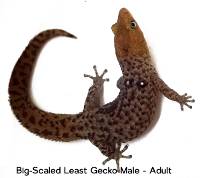Josh's Frogs
Big Scaled Least Gecko - Care Sheet
- Diurnal
- Easy to keep
- Unique patterns and colors
- Small size = less expensive setup
Name
Big-scaled least geckos ( Sphaerodactylus macrolepis ) are named for the large overlapping scales on their back. There are numerous subspecies, all of which inhabit Puerto Rico.Coloration
Big-scaled least geckos have a gray to light brown body and a yellow to orange tail, with dark brown to red dots running down the body. Juveniles and females often have two eyespots behind the neck, but these are sometimes lost in males as they reach sexual maturity. Most individuals have a couple of black markings on their head. Males are notably different in that they have a yellow head and chin, which remains a light gray color in females.
Housing
A pair of big-scaled least gecko adults can be housed in an 8x8x12 enclosure or a 12x12x12 enclosure . As with other micro geckos, they are best kept solo or as a pair. Sphaerodactylus micro geckos are equipped with toe pads and can climb smooth surfaces like glass; because hatchlings and juveniles are very small, any accessible escape routes must be secured! Substrates like DigIt , Coco Select , and other coco-fiber based substrates work well. Sand-soil mixtures can also be used. A bioactive substrate can be made using BioBedding with springtails and isopods , offering your geckos additional food sources and reducing the need to spot clean. The substrate should be kept slightly moist. Big-scaled least geckos are diurnal and terrestrial. They should be provided with plenty of hiding places. A layer of leaf litter over the substrate is recommended, but additional hides should also be provided. Cork bark and similar items can be used as hides. Live plants are always a welcome addition to the ocellated gecko’s enclosure. Though they are primarily terrestrial, big-scaled least geckos will take advantage of climbing material. Rocks, driftwood, cork bark , and manzanita branches can be provided in the enclosure. While this species has not been observed digging, they’re small and at risk of being crushed, so we strongly recommend ensuring that any heavy enclosure items be securely placed and supported by the bottom of the enclosure instead of the substrate.Temperature
During the day, least geckos should be kept at temperatures ranging from 75 to 80 F. A heat source is not necessary if stable temperatures are maintained. If a heat source is provided, use a low wattage heat pad or bulb to prevent overheating. Despite being a diurnal species, UV lighting for this species is a matter of debate. If UV light is used, a 2.0 or 5.0 bulb should be used, and plenty of shaded areas should be provided in the enclosure. Temperatures should not fall below 65 F at night.Humidity
Ocellated geckos enjoy a drier humidity than many of the other micro geckos and should be kept at 55-65% humidity. This species should be misted daily or every other day to maintain elevated humidity and to provide water droplets on the enclosure walls, leaf litter, and other cage items from which the geckos can drink. It is important to ensure that the enclosure has enough ventilation that it dries out after a few hours. A shallow water dish can be provided but is not necessary with consistent misting. Live plants will help create humid microclimates within the enclosure. Both temperature and humidity should be monitored with a digital thermometer/hygrometer .Size
Big-scaled least geckos are a little over an inch when they hatch out. Adults reach around 2.5-2.7 inches as adults. It is estimated that this gecko lives about 10-20 years in captivity.




